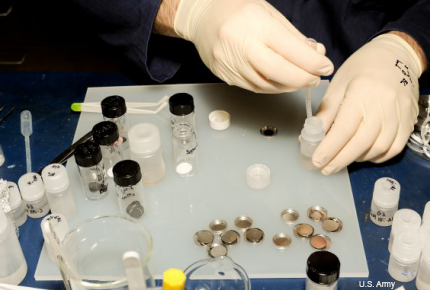Army lab is engineering better batteries
ARL chemists are using new methods and materials to make a battery that is lighter and more efficient.

Researchers are testing new approaches to generating power, starting with coin-sized models.
Any solider will be the first to admit that the amount of equipment they carry adds up, so it is always seen as a positive when the military can lighten the load. The Army Research Laboratory is pitching in, developing batteries that are lighter, more efficient and less corrosive.
ARL has begun its testing on small-sized coin models, roughly comparable to watch batteries, according to an Army release. The lab’s design is produced by combining cells within the battery to facilitate a more energized and efficient transfer of lithium ions, which transfer charges and ultimately provide the power. ARL is able to make its batteries lighter by using electrodes to increase the voltage of each individual cell in a battery pack, and thus use fewer parts.
This has not gone off without hitches, however. As researches noted, increasing voltage can cause corrosion due to a reaction between the highly energized electrode and the electrolytes, or acidic solution within the battery cell. To address this, the ARL research team developed a particular chemical solution to protect the vulnerable electrodes and make them less susceptible to degradation in high-voltage situations. ARL’s prototype can also be recharged several times.
"We help to develop new battery materials that are lighter and last longer for the soldier, so he doesn't have to carry so many batteries," Cynthia Lundgren, Chief of the Electrochemistry Branch of the Power and Energy Division in the Sensors and Electron Devices Directorate, said in the release.
ARL hopes to test larger pouch cells from commercial manufactures in 2015 to evaluate their durability as compared to their smaller coin model. Researchers are unable to see what is called gassing, a reaction between the electrolyte and the electrode, because the coin models are not large enough. In pouch cells, if gassing occurs, the cell will explode.
NEXT STORY: Pentagon names first Marine to lead DIA




